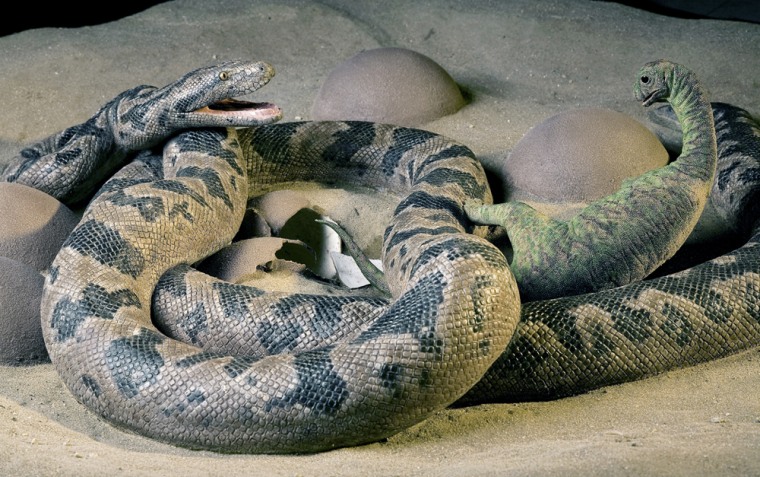Remains of an enormous snake have been discovered in a 67-million-year-old dinosaur nest, according to a new study. The snake was found coiled around a crushed dinosaur egg and next to what was left of a hatchling titanosaur.
This preserved moment in Cretaceous time provides the first direct evidence of the feeding behavior of a primitive snake, co-author Jason Head told Discovery News. Aside from this discovery, two other similar snake-egg pairings were also found at the site, located in what is now Gujarat in western India.
The 11.5-foot-long snake, described in the latest PLoS Biology, represents a new species, Sanajeh indicus, meaning "ancient-gaped one from the Indian subcontinent."
"It was not necessarily a specialized constrictor, but it clearly grabbed dinosaur hatchlings and gobbled them down," said Head, a paleontologist and assistant professor in the Department of Biology at the University of Toronto Mississauga.
"Sauropods laid their eggs in nests covering several hundred miles, so the newly hatched dinosaurs would have been like meatballs on a smorgasbord for the snakes," he added.
Dinosaur egg expert Dhananjay Mohabey from the Geological Survey of India first found the fossils in 1987. A formal agreement with the Government of India Ministry of Mines in 2004 allowed for additional study, fieldwork and other experts to come into the project. The best-preserved snake and nest set was brought to the University of Michigan Museum of Paleontology to facilitate analysis.
"The eggs were laid in loose sands and covered by a thin layer of sediment," said Mohabey. "We think that the hatchling had just exited from its egg, and its movement attracted the snake."
Head added that, based on the geology of the site and the manner in which the fossils were preserved, a storm probably caused a sandy mudslide that buried the snake and remaining dinosaur hatchlings alive.
The parents, 70-foot-long titanosaur adults, were not present. "There was no evidence of parental care," Head said.
Even if these adult dinosaurs did encounter snakes, he doubts the lumbering plant-eating animals would have been very skillful at stomping out a fast moving snake.
He compared the scenario to modern sea turtles, which lay their eggs on the beach and then return to the ocean. When the turtle eggs hatch, "it's like a dinner bell for the ecosystem," Head said. The 1.6-foot-long baby dinosaurs would have been just as defenseless when facing large snake predators.
Snakes, therefore, probably helped to keep sauropod populations in check sometime after 100 million years ago, when snakes began to appear in the fossil record. The huge body of Sanajeh helped it to pack in such dinosaur meals.
"This points to an interesting evolutionary strategy for primitive snakes to eat large prey by increasing their body size," he explained.
As a species, Sanajeh was so successful that it actually survived the devastating mass extinction event 65.5 million years ago that wiped out all non-avian dinosaurs. In fact, this snake species lived on into early human history, according to Head.
A life-size reconstruction of the snake-eats-dinosaur scene, created by University of Chicago paleoartist Tyler Keillor, will be donated to the Geological Survey of India at a formal event in Mumbai on March 12.
